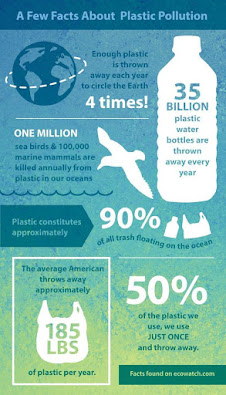Single-Use Plastic (SUP) is produced and designed to be used once and then be thrown away like plastic bottles, plastic bags and disposable straws. India produces 300 million tons of plastic each year and half of it is disposable. Worldwide wide only 10-13% of plastic is recycled. Petroleum-based plastic is non-biodegradable, it degrades into tiny particles after many many years and in the process of breaking down, it releases toxic chemicals which make their way into our food and water supply. These toxic chemicals are now being found in our bloodstream and the latest research has found them to disrupt the Endocrine system which can cause cancer, infertility, birth defects, impaired immunity and many other ailments.
The Indian government has identified single-use plastic items to be banned based on an index of their utility and environmental impact. Environmental experts have welcomed this move while plastic manufacturers have expressed reservations and asked for putting off the ban by a year on account of the pandemic-induced economic slump. Opposition from the plastics industry will make it tougher to effectively implement the ban, given how poorly existing bans have been enforced – as seen from a recent order of the National Green Tribunal – and due to shortcomings in the draft notification, such as questions over alternatives to single-use plastic items, experts say.
What's Proposed?
The new draft will replace the existing rules on plastic waste management which were notified in 2016 and amended in 2018. The 2021 draft rules have proposed to prohibit the manufacture, import, stocking, distribution and sale of certain single-use plastics from January 1, 2022.
After seeking suggestions and objections on the draft from citizens and stakeholders for a period of two months until May 11, the ministry is currently deliberating on the feedback it has received.
In the three-stage ban, the first category of single-use plastic items proposed to be phased out is plastic sticks used in balloons, flags, candy, ice-cream and earbuds and thermocol that is used in decorations.
The second category proposed to be banned from July 1, 2022, includes items such as plates, cups, glasses and cutlery such as forks, spoons, knives, straws, trays, wrapping and packing films used in sweet boxes, invitation cards, cigarette packets, stirrers and plastic banners that are less than 100 microns in thickness.
The third category of prohibition is for non-woven bags below 240 microns in thickness. This is proposed to start from September 30, 2022.
The draft has, for the first time, defined non-woven plastic bags – widely used as shopping bags – and brought brand owners (selling single-use plastic under a registered brand name) as well as plastic waste processors under its ambit.
It has also, for the first time, defined thermoset plastic – which is irreversibly rigid and cannot be remoulded – and thermoplastics, which soften on heating. Thermoset plastics are used in electrical fittings and tableware whereas thermoplastics are used in items such as toys, combs and mugs.
The draft also proposes to increase the thickness of carry bags made out of virgin or recycled plastic from 50 microns to 120 microns. The 2016 rules have already prohibited the use of plastic bags and sheets whose thickness is below 50 microns.
How can citizens help?
The fight against plastic waste starts with individual action. These are some simple steps to seriously reduce your plastic use right now.
1. Carry reusable plastic bags.
2. Drink coffee from a reusable cup.
3. Avoid bottled water.
4. Steer clear of plastic straws.
5. Switch to plastic-free chewing gum.
6. Shop at farmer's market.
7. Swap out bottles for bars.
8. Avoid buying clothes made with plastic.
9. Compost food waste.
10. Stop using un-refillable lighters.
11. Use razors with replaceable blades instead of a disposable razor.
12. Pack your lunch in reusable containers and bags.
13. Buy boxes instead of bottles for products like detergent
14. Reuse containers for storing leftovers or shopping in bulk.
15. Bring your own container for take-out.




:) well done bro..!
ReplyDeleteVery nice
ReplyDeleteToo good aanya:)
ReplyDeleteVery informative